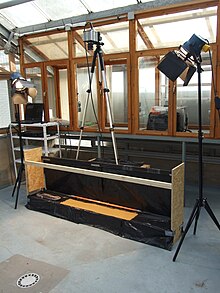Neoichnology
The neoichnology ( Greek. Neos 'new' Ichnos "footprint" logos "doctrine") is the study of the tracks and traces of recent , that is still living, animals. It stands in opposition to the palichnology , which deals with the traces of life of fossil animals. Neoichnological methods are used to study the locomotion of invertebrates as well as vertebrates . Corresponding findings are of great importance for palichnology or paleobiology , as they help to better interpret fossil traces (recent comparison).
Methods of Neoichnology
Working with live animals
When working with live animals, a running track is typically prepared which contains a substrate for track generation, e.g. B. sand of different moisture, clay or clayey silt . The test animal is then lured or driven over this test track, leaving traces on the substrate. Sometimes the animal is filmed while the trail is being generated in order to subsequently study the effects of the running speed or the behavior of the animal on the resulting trail. At the same time, this is an important advantage of working with living animals: changes in direction or speed, slipping of the animal and moments of shock are visible in the tracks. After each test run, the resulting track can be photographed, poured or drawn before the track can be reused after the substrate has been smoothed. A variation of the experimental setup is possible at any time, e.g. B. a change in the moisture content of the substrate. As an alternative to this approach, natural tracks in nature can also be studied without a special test setup (e.g. near water). Without the standardized environment in the laboratory, however, it is much more difficult to relate traces to animal behavior. An example of a relatively early neoichnological study was provided by the German geologist Ferdinand Trusheim , who examined recent traces of "tadpole shrimp" of the species Triops cancriformis at the beginning of the 1930s .
Working with foot models or severed limbs
Working with foot models or separated limbs can be defined as a further field of methods, whereby the behavior of the animal during the creation of tracks is largely hidden. In this procedure, the prepared foot is also brought into an area with substrate that allows a trace to be created. In contrast to working with living animals, there is now the possibility for the experimenter to manually regulate the footstep (direction, speed, depth) and to study the effects on the track. The superimposition of differently colored substrate layers also offers the possibility of examining the effects of the occurrence on deeper substrate layers.
literature
- ^ A b Robert B. Davis, Nicholas J. Minter, Simon J. Braddy: The neoichnology of terrestrial arthropods . In: Palaeogeography, Palaeoclimatology, Palaeoecology . tape 255 , no. 3–4 , November 13, 2007, pp. 284–307 , doi : 10.1016 / j.palaeo.2007.07.013 .
- ^ A b c Stefan Curth, Martin S. Fischer, John A. Nyakatura: Ichnology of an Extant Belly-Dragging Lizard — Analogies to Early Reptile Locomotion? In: Ichnos . tape 21 , no. 1 , January 2, 2014, p. 32-43 , doi : 10.1080 / 10420940.2013.877006 .
- ↑ a b Tai Kubo: Extant Lizard Tracks: Variation and Implications for Paleoichnology . In: Ichnos . tape 17 , no. 3 , August 31, 2010, p. 187–196 , doi : 10.1080 / 10420940.2010.502500 .
- ↑ Jesper Milàn: Variations in the Morphology of Emu (dromaius Novaehollandiae) Tracks Reflecting Differences in Walking Pattern and Substrate Consistency: Ichnotaxonomic Implications . In: Palaeontology . tape 49 , no. 2 , March 1, 2006, p. 405-420 , doi : 10.1111 / j.1475-4983.2006.00543.x .
- ↑ a b Kevin Padian, Paul E. Olsen: Footprints of the Komodo Monitor and the Trackways of Fossil Reptiles . In: Copeia . tape 1984 , no. 3 , August 1984, pp. 662-671 , doi : 10.2307 / 1445147 .
- ↑ Jorge F. Genise, Ricardo N. Melchor, Miguel Archangelsky, Luis O. Bala, Roberto Straneck, Silvina de Valais: Application of neoichnological studies to behavioral and taphonomic interpretation of fossil bird-like from lacustrine settings: The Late Triassic – Early tracks Jurassic? Santo Domingo Formation, Argentina . In: Palaeogeography, Palaeoclimatology, Palaeoecology . tape 272 , no. 3–4 , February 15, 2009, pp. 143–161 , doi : 10.1016 / j.palaeo.2008.08.014 .
- ↑ Ferdinand Trusheim: Aktuo-paleontological observations on Triops cancriformis Schaeffer (Crust. Phyll.). In: Senckenbergiana . 13, 1931, pp. 234-243.
- ↑ J. MILAN, RG Bromley: tracks True, under tracks and eroded tracks, experimental work with tetrapod tracks in laboratory and field . In: Palaeogeography, Palaeoclimatology, Palaeoecology . tape 231 , no. 3–4 , February 28, 2006, pp. 253–264 , doi : 10.1016 / j.palaeo.2004.12.022 .
Web links
- Blue-tongued Skink ( Tiliqua scincoides ) Moving on Clay Track. High-speed recording of the sequence of movements of a blue-tongue skink at the Lokomotion including the step seal that it leaves behind (YouTube).
